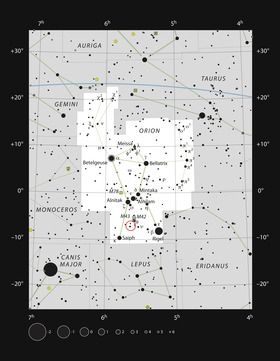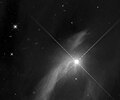V883 Orionis
 The location of V883 Orionis (circled) | |
| Observation data Epoch J2000 Equinox J2000 | |
|---|---|
| Constellation | Orion |
| Right ascension | 05h 38m 18.102s[1] |
| Declination | −07° 02′ 26.02″[1] |
| Characteristics | |
| Variable type | FU Ori |
| Astrometry | |
| Proper motion (μ) | RA: −0.938[1] mas/yr Dec.: +1.490[1] mas/yr |
| Parallax (π) | 1.5259 ± 0.2923 mas[1] |
| Distance | 414[2] pc |
| Details | |
| Mass | 1.29±0.02[2] M☉ |
| Luminosity (bolometric) | 195[3] L☉ |
| Age | 0.5[2] Myr |
| Other designations | |
V883 Ori, HBC 489 | |
| Database references | |
| SIMBAD | data |
V883 Orionis is a protostar in the constellation of Orion. It is associated with IC 430 (Haro 13A), a peculiar Hα object surveyed by Guillermo Haro in 1952.[4] It is assumed to be a member of the Orion Nebula cluster at 414±7 pc.[2]
V883 Orionis, like most protostars, is surrounded by a circumstellar disc of dust. The dust has a water snow-line, a certain distance where the stellar irradiance from the star is low enough that water can freeze to snow. The water snow-line was directly imaged by ALMA, when a stellar outburst increased the amount of insolation and pushed the line out farther.[2] In 2023, it was announced that signs of water vapor had been detected in V883 Orionis' disc.[5]
Gallery
- Artist's impression of the planet-forming disc around V883 Orionis
- Informative video about the planet-forming disc around V883 Orionis
-
 Artist's impression of the water snow line around V883 Orionis, detected with ALMA
Artist's impression of the water snow line around V883 Orionis, detected with ALMA -
 IC 429 and IC 430 next to the bright foreground star 49 Ori. V883 Ori is the faint star just beyond the tip of IC 429.
IC 429 and IC 430 next to the bright foreground star 49 Ori. V883 Ori is the faint star just beyond the tip of IC 429. -
 V883 Ori (bright star) and part of IC 429 with the Hubble Space Telescope
V883 Ori (bright star) and part of IC 429 with the Hubble Space Telescope
References
- ^ a b c d e Vallenari, A.; et al. (Gaia collaboration) (2023). "Gaia Data Release 3. Summary of the content and survey properties". Astronomy and Astrophysics. 674: A1. arXiv:2208.00211. Bibcode:2023A&A...674A...1G. doi:10.1051/0004-6361/202243940. S2CID 244398875. Gaia DR3 record for this source at VizieR.
- ^ a b c d e Cieza, Lucas A.; et al. (2016). "Imaging the water snow-line during a protostellar outburst". Nature. 535 (7611): 258–261. arXiv:1607.03757. Bibcode:2016Natur.535..258C. doi:10.1038/nature18612. PMID 27411631. S2CID 205249709.
- ^ Furlan, E. (May 2016). "The Herschel Orion Protostar Survey: Spectral Energy Distributions and Fits Using a Grid of Protostellar Models". The Astrophysical Journal Supplement Series. 224 (1): 5. arXiv:1602.07314. Bibcode:2016ApJS..224....5F. doi:10.3847/0067-0049/224/1/5.
- ^ Allen, D. A.; Strom, K. M.; Grasdalen, G. L.; Strom, S. E.; Merrill, K. M. (1975). "Haro 13a: A Luminous, Heavily Obscured Star in Orion?". Monthly Notices of the Royal Astronomical Society. 173: 47P–50P. Bibcode:1975MNRAS.173P..47A. doi:10.1093/mnras/173.1.47P.
- ^ "Astronomers find missing link for water in the Solar System". ESO. 8 March 2023. Retrieved 21 March 2023.
- v
- t
- e
| Bayer |
|
|---|---|
| Flamsteed | |
| Variable | |
| HR | |
| HD | |
| Other |
| Exoplanets |
|---|
clusters
| NGC | |
|---|---|
| Other |
|
| NGC | |
|---|---|
| Other |
| NGC | |
|---|---|
| Other |
| Astronomical events |
|
|---|
 Category
Category
 | This variable star–related article is a stub. You can help Wikipedia by expanding it. |
- v
- t
- e














